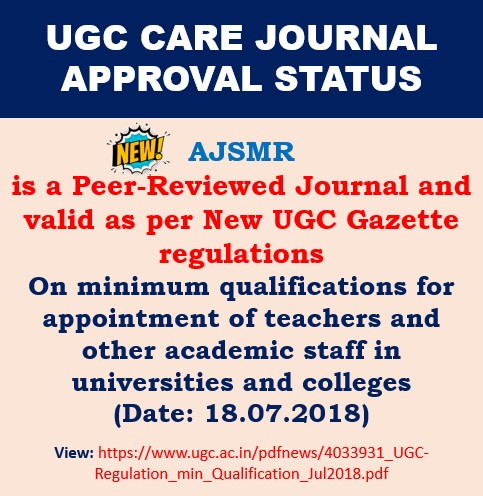Original Research Article I Volume 2 I Issue 4 I 2016
Relative Effectiveness of Integrated andConventional Approaches in Developing Teaching Competence
Yalavarthi Nirmala
The American Journal of Science and Medical Research; 2(4); 19-30
DOI:http://dx.doi.org/10.17812/ajsmr2405
Abstract:
Teachers’ content and pedagogical competence, their own views on teaching as an integrated professional activity and confidence in their own teaching abilities eventually determine their classroom practices and quality of students’ learning. The pre-service teacher education must attend to professional preparation of teachers. The review of developmental works in microteaching reveals that learning in microteaching also takes place in the cognitive and affective dimensions of the teaching ability besides its performance skill dimension. The integrated approach is conceptualised based on the premise that development of teacher competence needs to take account of training in the performance skill dimension and education in the cognitive and affective dimensions of the teaching ability.
Keywords:
Allen, D.W. and Ryan, K.A. (1969). Microteaching. Massachusetts: Addison Wesley Reading. [2]. Antoniou, Panayiotis; Kyriakides, Leonidas and Creemers, Bert (2011). Investigating the Effectiveness of a Dynamic Integrated Approach to Teacher Professional Development. CEPS Journal 1, 1, S 13-41. [3]. Argyle, M. (1969b). Social Skills Training in Education. Pedogogica Europaea, 5, 72-79. [4]. Bandura, A. (1977). Social Learning Theory. Englewood Cliffs, New Jersey: Prentice Hall. [5]. Brusling, C. (1974). Microteaching –A Concept in Development. Stockholm, Sweden: Almqvist and Wiksell. [6]. Buch, M.B. (1991). Fourth Survey of Research in Education. New Delhi: NCERT. [7]. Cakiroglu, E. (2000). Preservice elementary teachers’ sense of efficacy in reform oriented mathematics (Unpublished doctoral dissertation).Indiana University, USA. [8]. Cone, N. (2009). Pre-service elementary teachers’ selfefficacy beliefs about equitable science teaching: Does service learning make a difference? Journal of Elementary Science Education 21, 2, 25-34. [9]. Cooney, T.J., Davis, E.J., & Henderson, K.B. (1975). Dynamics of Teaching Secondary School Mathematics. Boston: Houghton Miffling. [10]. Dorasami, K. (1986). Development of Competency-Based Curriculum Design for Methodology of Teaching Mathematics and its Validation. An unpublished Ph.D Thesis, Mysore: Mysore University
References:
[1]. Allen, D.W. and Ryan, K.A. (1969). Microteaching.Massachusetts: Addison Wesley Reading.
[2]. Antoniou, PanayiotisKyriakides, Leonidas andCreemers, Bert (2011). Investigating the Effectiveness of aDynamic Integrated Approach to Teacher ProfessionalDevelopment. CEPS Journal 1, 1, S 13-41.
[3]. Argyle, M. (1969b). Social Skills Training in Education.Pedogogica Europaea, 5, 72-79.
[4]. Bandura, A. (1977). Social Learning Theory. EnglewoodCliffs, New Jersey: Prentice Hall.
[5]. Brusling, C. (1974). Microteaching –A Concept inDevelopment. Stockholm, Sweden: Almqvist and Wiksell.
[6]. Buch, M.B. (1991). Fourth Survey of Research inEducation. New Delhi: NCERT.
[7]. Cakiroglu, E. (2000). Preservice elementary teachers’ senseof efficacy in reform oriented mathematics (Unpublisheddoctoral dissertation).Indiana University, USA.
[8]. Cone, N. (2009). Pre-service elementary teachers’ selfefficacy beliefs about equitable science teaching: Doesservice learning make a difference? Journal of ElementaryScience Education 21, 2, 25-34.
[9]. Cooney, T.J., Davis, E.J., & Henderson, K.B. (1975).Dynamics of Teaching Secondary School Mathematics.Boston: Houghton Miffling.
[10]. Dorasami, K. (1986). Development of Competency-BasedCurriculum Design for Methodology of TeachingMathematics and its Validation. An unpublished Ph.DThesis, Mysore: Mysore University...
Article Dates:
Received: 21 September 2016; Accepted: 18 November 2016; Published: 28 December 2016
How To Cite:
http://dx.doi.org/10.17812/ajsmr2405



